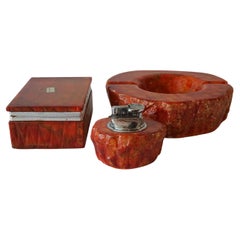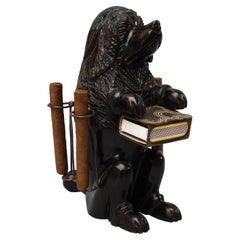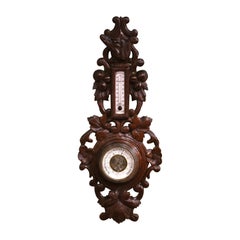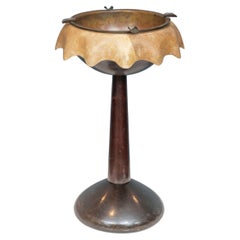Zus Korsten Tobacco Accessories
to
3
3
3
1
1
2
1
1
1
2
2
1
1
1
3
1
1
1
3
3
3
1960s Italian Three Piece Orange Genuine Hand Carved Alabaster Smoking Set
Located in Haarlem, NL
Very decorative 1960s Italian hand carved orange alabaster smoking set by Romano Bianchi.
Consists of a heavy ashtray, also very useful as trinket dish or vide-poche.
A table lighter (which also fits a wax tea light candle).
And a very pretty lidded hinged box, which originally would have held cigarettes but also could be used to keep jewellery or little treasures in.
Cigarette sales peaked in the 20th century, people were allowed to smoke in the office, the cinema, at restaurants, indoors and outdoors. Once women were able to smoke freely, smoking became a social norm and in general it was considered an act of elegance and sophistication. Businessmen in the 1960s were rarely seen without a cigarette in their hand.
So needles to say you needed pretty smoking accessories...
Category
Vintage 1960s Italian Mid-Century Modern Tobacco Accessories
Materials
Alabaster
$600 Sale Price / set
20% Off
1900 Swiss Black Forest Carved Basswood Begging Dog Cigar and Matchbox Holder
Located in Haarlem, NL
Swiss Brienz black forest hand carved linden wood begging poodle with brass matchbox holder and four brass cigar holders.
Black Forest wood carved art ...
Category
Antique Late 19th Century Swiss Black Forest Tobacco Accessories
Materials
Brass
$1,400 Sale Price
20% Off
Set of Ten 19th Century English Victorian Brass Chimney Good Luck Shoes or Boots
Located in Haarlem, NL
Four sets and two single pieces of English Victorian brass chimney ornaments or "good luck" shoes.
What a lovely collection of shiny shoes don't you think? Let me tell you a little bit about them,
during the Victorian period in England, it was fashionable to have a pair of "good luck" brass shoes on your mantel (fireplace), they would been given to you as a wedding gift.
Two sets were definitely match stick holders...
Category
Antique Mid-19th Century British Victorian Models and Miniatures
Materials
Brass
$1,320 Sale Price / set
20% Off
Related Items
19th Century French Forest Carved Oak Barometer and Thermometer with Dog Motif
Located in Dallas, TX
This elegant antique wall hanging barometer and thermometer was crafted in France, circa 1890. The carved oak weather and temperature reader features impressive, high-relief carvings of acorn and leaf motifs throughout; it is further embellished with a dog head sculpture at the pediment. The thermometer with Celsius and Fahrenheit reading, and the weather forecast seem to be in working order. The Black Forest weather...
Category
Antique Late 19th Century French Black Forest Scientific Instruments
Materials
Oak
$675
H 24 in W 10 in D 3 in
Aldo Tura Smoking Stand, Italy
By Aldo Tura
Located in San Francisco, CA
Aldo Tura smoking stand made from stained fruitwood and a scalloped parchment covered top.
A patinated nickel and copper plated ashtray with cigarette ...
Category
Vintage 1950s Italian Mid-Century Modern Tobacco Accessories
Materials
Fruitwood, Parchment Paper
Miniature 19th Century Victorian Figured Mahogany Chest of Drawers
Located in Morristown, NJ
19th c. Charming antique miniature chest of drawers. The chest has a marble top. The case is figured mahogany, with four stacked drawers, the ...
Category
Antique Mid-19th Century English Late Victorian Models and Miniatures
Materials
Marble, Brass
Rare 19th Century English Tunbridgeware Hair Pin or Slide
Located in Dallas, TX
PRESENTING an EXTREMELY UNIQUE and RARE 19C British Tunbridgeware Hair Pin/Bobbin or Slide.
This slide is unlike any of it’s kind we have seen before, it is a VERY RARE survivor.
From circa 1860 – 80 and made in Tunbridge Wells, England.
Made of walnut with gorgeous marquetry inlay on the entirety of the front with classic Tunbridgeware micro-mosaic all over the front. The rear is walnut.
The marquetry inlay appears to be various different woods, namely, maple, walnut and satinwood.
Would have been worn in a Lady’s hair bun with the micro-mosaic facing forward.
This would have belonged to a VERY ELEGANT LADY in the mid to late 19th Century.
Tunbridge ware is a form of decoratively inlaid woodwork, typically in the form of boxes, that is characteristic of Tonbridge and the spa town of Royal Tunbridge Wells in Kent in the 18th and 19th centuries. The decoration typically consists of a mosaic of many very small pieces of different coloured woods that form a pictorial vignette. Shaped rods and slivers of wood were first carefully glued together, then cut into many thin slices of identical pictorial veneer with a fine saw. Elaborately striped and feathered bandings for framing were pre-formed in a similar fashion.
There is a collection of Tunbridge ware in the Tunbridge Wells Museum and Art Gallery in Tunbridge Wells.
The famous makers of Tunbridge ware were in the Tunbridge Wells area of Kent; their most notable work was from circa 1830-1900.
Early makers of Tunbridge ware, in Tunbridge Wells in the mid-18th century, were the Burrows family, and Fenner and Co. In the 19th century, around 1830, James Burrows invented a technique of creating mosaics from wooden tesserae. Henry Hollamby, apprenticed to the Burrows family, set up on his own in 1842 and became an important manufacturer of Tunbridge ware, employing about 40 people.
Edmund Nye (1797–1863) and his father took over the Fenner company when William Fenner retired in 1840, after 30 years in partnership with him. Thomas Barton (1819–1903), previously apprenticed at the Wise factory, joined the Nyes in 1836, and worked as Nye’s designer; he took over the business in 1863 and continued there until his death.
In Tonbridge (near to Tunbridge Wells), George Wise (1703–1779) is known to have had a business in 1746. It continued with his son Thomas, and Thomas’s nephew George (1779–1869), who took over in 1806. In its early years the company made articles such as workboxes and tea caddies with prints of popular views; later items had pictures created from mosaics. Their workshop in Tonbridge, Wise’s Tunbridge Ware Manufactory, was next to the Big Bridge over the Medway; the building was demolished in 1886 to widen the approach to the bridge.
Tunbridge ware became popular with visitors to the spa town of Tunbridge Wells, who bought them as souvenirs and gifts. Articles included cribbage boards, paperweights, writing slopes, snuffboxes and glove boxes.
At the Great Exhibition of 1851, Tunbridge ware by Edmund Nye, Robert Russell and Henry Hollamby was shown; Edmund Nye received a commendation from the judges for his work. He exhibited a table depicting a mosaic of a ship at sea; 110,800 tesserae were used in making the picture.
The manufacturers of Tunbridge ware were cottage industries, and they were no more than nine in Tunbridge Wells and one in Tonbridge. The number declined in the 1880s; competent craftsmen were hard to find, and public tastes changed. After the death of Thomas Barton in 1903 the only surviving firm was Boyce, Brown and Kemp, which closed in 1927.
Marquetry was an old technique which was continued by Nye and Barton to create images such as birds or butterflies.
‘Green Oak’ as caused by the fungus Chlorociboria aeruginascens.
Stickware and half-square mosaic was invented by James Burrows in about 1830: a bunch of wooden sticks of different colours, each having triangular or diamond-shaped cross section, were tightly glued together; in the case of stickware, the resulting block was dried, then turned to form an article such as the base of a pincushion. For half-square mosaic, thin slices were taken from the composite block, and applied to a surface.
Tesselated mosaic, was a development by James Burrows of half-square mosaic; it was adopted by George Wise and Edmund Nye. Minute tesserae were used to form a wide variety of geometric and pictorial designs.
Many sorts of wood were used for the various colours; about 40 were in regular use. Only natural colors were used; green was provided by “green oak”, produced by the action of fungus on fallen oak. Designs for articles were often taken from designs of Berlin wool work.
Category
Antique Late 19th Century English High Victorian Collectible Jewelry
Materials
Satinwood, Walnut
Antique 19th Century English Victorian Era Walnut Chess Table, Circa 1885
Located in New Orleans, LA
Antique 19th century English Victorian era walnut chess table, circa 1885.
Category
Antique 19th Century English Victorian Game Tables
Materials
Walnut
Smoking set Knuth and manufactured Soldi & Scati
Located in Guazzora, IT
The original 1950s emerald green resin ashtray with lighter, designed by designer Knuth, is a charming piece of midcentury design. This period, known for its clean lines, innovative...
Category
Vintage 1950s Italian Mid-Century Modern Tobacco Accessories
Materials
Steel
Pair of 19th Century Brass Parabolic Reflectors
Located in Chicago, IL
In the 19th century, parabolic reflectors such as these were employed in scientific experiments to study the behavior of light, heat, and sound. These brass parabolic mirrors, when p...
Category
Antique 19th Century American Victorian Scientific Instruments
Materials
Brass
Pair of Late 19th Century English Riding Boots
Located in Chicago, IL
This striking pair of late 19th-century English black leather riding boots is a handsome relic of the sporting life. Crafted with exceptional care, the boots retain their original fo...
Category
Antique Late 19th Century English Edwardian Sports Equipment and Memorab...
Materials
Leather, Wood
$1,350 Sale Price / set
25% Off
H 24.5 in W 11.5 in D 3.5 in
Decorative Fancy Victorian Barometer, 19th Century
Located in Berlin, DE
Fancy Victorian barometer, 19th century
Mahogany veneer with inlay. Historical condition. The barometer may need to be checked for accuracy. Ple...
Category
Antique 19th Century English Victorian Scientific Instruments
Finely Carved 'Black Forest' Pipe Stand
By Black Forest
Located in Forest Row, East Sussex
A finely carved "Black Forest' pipe stand. Carved Lindenwood with a single bear standing over a naturalistic base with the pipe holders and astray to fron...
Category
Antique Late 19th Century Swiss Black Forest Tobacco Accessories
Materials
Wood
1960s, Stunning Alabaster Smoking Set by Romano Bianchi
Located in Milano, IT
1960s Stunning alabaster smoking set by Romano Bianchi with ashtray, cigarette box and table lighter, everything is handmade carved. Made in Italy. This smoking set is in excellent c...
Category
Vintage 1960s Italian Mid-Century Modern Tobacco Accessories
Materials
Alabaster
1960s, Stunning Alabaster Smoking Set by Romano Bianchi
Located in Milano, IT
1960s Gorgeous alabaster smoking set by Romano Bianchi with ashtray, box and table lighter, everything is handmade carved. Made in Italy. This smoking set is in excellent condition.
...
Category
Vintage 1960s Italian Mid-Century Modern Tobacco Accessories
Materials
Alabaster
$368 Sale Price / set
20% Off
H 2.36 in W 6.69 in D 7.87 in




